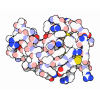[English] 日本語
 Yorodumi
Yorodumi- PDB-2b7x: Sequential reorganization of beta-sheet topology by insertion of ... -
+ Open data
Open data
- Basic information
Basic information
| Entry | Database: PDB / ID: 2b7x | ||||||
|---|---|---|---|---|---|---|---|
| Title | Sequential reorganization of beta-sheet topology by insertion of a single strand | ||||||
 Components Components | Lysozyme | ||||||
 Keywords Keywords |  HYDROLASE / sequence duplication / HYDROLASE / sequence duplication /  protein design / structural switches / protein design / structural switches /  tandem repeat tandem repeat | ||||||
| Function / homology |  Function and homology information Function and homology informationviral release from host cell by cytolysis / peptidoglycan catabolic process / cell wall macromolecule catabolic process /  lysozyme / lysozyme /  lysozyme activity / host cell cytoplasm / defense response to bacterium lysozyme activity / host cell cytoplasm / defense response to bacteriumSimilarity search - Function | ||||||
| Biological species |   Enterobacteria phage T4 (virus) Enterobacteria phage T4 (virus) | ||||||
| Method |  X-RAY DIFFRACTION / X-RAY DIFFRACTION /  SYNCHROTRON / SYNCHROTRON /  MOLECULAR REPLACEMENT / Resolution: 3 Å MOLECULAR REPLACEMENT / Resolution: 3 Å | ||||||
 Authors Authors | Sagermann, M. / Matthews, B.W. | ||||||
 Citation Citation |  Journal: Protein Sci. / Year: 2006 Journal: Protein Sci. / Year: 2006Title: Sequential reorganization of beta-sheet topology by insertion of a single strand. Authors: Sagermann, M. / Baase, W.A. / Matthews, B.W. #1:  Journal: Proc.Natl.Acad.Sci.USA / Year: 2003 Journal: Proc.Natl.Acad.Sci.USA / Year: 2003Title: Long distance conformation changes in a protein engineered by modulated sequence duplication Authors: Sagermann, M. / Gay, L. / Mattews, B.W. #2:  Journal: Proc.Natl.Acad.Sci.USA / Year: 1999 Journal: Proc.Natl.Acad.Sci.USA / Year: 1999Title: Structural characterization of an engineered tandem repeat contrasts the importance of context and sequence in protein folding Authors: Sagermann, M. / Baase, W.A. / Matthews, B.W. | ||||||
| History |
|
- Structure visualization
Structure visualization
| Structure viewer | Molecule:  Molmil Molmil Jmol/JSmol Jmol/JSmol |
|---|
- Downloads & links
Downloads & links
- Download
Download
| PDBx/mmCIF format |  2b7x.cif.gz 2b7x.cif.gz | 135.9 KB | Display |  PDBx/mmCIF format PDBx/mmCIF format |
|---|---|---|---|---|
| PDB format |  pdb2b7x.ent.gz pdb2b7x.ent.gz | 106.8 KB | Display |  PDB format PDB format |
| PDBx/mmJSON format |  2b7x.json.gz 2b7x.json.gz | Tree view |  PDBx/mmJSON format PDBx/mmJSON format | |
| Others |  Other downloads Other downloads |
-Validation report
| Arichive directory |  https://data.pdbj.org/pub/pdb/validation_reports/b7/2b7x https://data.pdbj.org/pub/pdb/validation_reports/b7/2b7x ftp://data.pdbj.org/pub/pdb/validation_reports/b7/2b7x ftp://data.pdbj.org/pub/pdb/validation_reports/b7/2b7x | HTTPS FTP |
|---|
-Related structure data
| Related structure data |  3jr6C 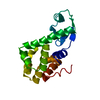 3lzmS C: citing same article ( S: Starting model for refinement |
|---|---|
| Similar structure data |
- Links
Links
- Assembly
Assembly
| Deposited unit | 
| ||||||||
|---|---|---|---|---|---|---|---|---|---|
| 1 | 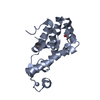
| ||||||||
| 2 | 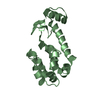
| ||||||||
| 3 | 
| ||||||||
| 4 | 
| ||||||||
| Unit cell |
|
- Components
Components
| #1: Protein |  / Lysis protein / Muramidase / Endolysin / Lysis protein / Muramidase / EndolysinMass: 19233.061 Da / Num. of mol.: 4 Mutation: C54T, C97A, residues (YTIGIG) inserted after residue G30 Source method: isolated from a genetically manipulated source Source: (gene. exp.)   Enterobacteria phage T4 (virus) / Genus: T4-like viruses / Species: Enterobacteria phage T4 sensu lato / Gene: E / Plasmid: phs1403 / Production host: Enterobacteria phage T4 (virus) / Genus: T4-like viruses / Species: Enterobacteria phage T4 sensu lato / Gene: E / Plasmid: phs1403 / Production host:   Escherichia coli (E. coli) / Strain (production host): rr1 / References: UniProt: P00720, Escherichia coli (E. coli) / Strain (production host): rr1 / References: UniProt: P00720,  lysozyme lysozyme#2: Chemical | ChemComp-SO4 /  Sulfate Sulfate |
|---|
-Experimental details
-Experiment
| Experiment | Method:  X-RAY DIFFRACTION / Number of used crystals: 1 X-RAY DIFFRACTION / Number of used crystals: 1 |
|---|
- Sample preparation
Sample preparation
| Crystal | Density Matthews: 2.23 Å3/Da / Density % sol: 44.9 % |
|---|---|
Crystal grow | Temperature: 298 K / Method: vapor diffusion, hanging drop / pH: 7.8 Details: Polyehtylene glycol 4000, 50mM Ammonium sulfate, , pH 7.8, VAPOR DIFFUSION, HANGING DROP, temperature 298K |
-Data collection
| Diffraction | Mean temperature: 110 K |
|---|---|
| Diffraction source | Source:  SYNCHROTRON / Site: SYNCHROTRON / Site:  ALS ALS  / Beamline: 5.0.2 / Wavelength: 1 Å / Beamline: 5.0.2 / Wavelength: 1 Å |
| Detector | Type: ADSC QUANTUM 4 / Detector: CCD / Date: Nov 6, 1998 / Details: mirrors |
| Radiation | Monochromator: mirrors on si-crystal / Protocol: SINGLE WAVELENGTH / Monochromatic (M) / Laue (L): M / Scattering type: x-ray |
| Radiation wavelength | Wavelength : 1 Å / Relative weight: 1 : 1 Å / Relative weight: 1 |
| Reflection | Resolution: 3→20 Å / Num. all: 14371 / Num. obs: 10387 / % possible obs: 72.3 % / Observed criterion σ(F): 0 / Observed criterion σ(I): 0 / Rmerge(I) obs: 0.065 / Net I/σ(I): 7.4 |
| Reflection shell | Resolution: 3→3.25 Å / % possible all: 66.5 |
- Processing
Processing
| Software |
| ||||||||||||||||||||
|---|---|---|---|---|---|---|---|---|---|---|---|---|---|---|---|---|---|---|---|---|---|
| Refinement | Method to determine structure : :  MOLECULAR REPLACEMENT MOLECULAR REPLACEMENTStarting model: pdb entry 3LZM, Resolution: 3→20 Å / Cross valid method: THROUGHOUT / σ(F): 0 / Stereochemistry target values: Engh & Huber Details: data was collected on very fragile, thin crystal plates resulting in low occupancy of reflections in data set. Several (non-isomorphous data sets were collected to further verify ...Details: data was collected on very fragile, thin crystal plates resulting in low occupancy of reflections in data set. Several (non-isomorphous data sets were collected to further verify interpretation. Refinement was carried out with the programs refmac and CNS.the sequence between residues 32 and 44 (new mutant numbering) were deleted from the model due to poor density. The c-terminal residues N169 and L170 (new mutant numbering) could not be identified in the density and were therefore omitted.
| ||||||||||||||||||||
| Displacement parameters |
| ||||||||||||||||||||
| Refinement step | Cycle: LAST / Resolution: 3→20 Å
| ||||||||||||||||||||
| Refine LS restraints |
|
 Movie
Movie Controller
Controller



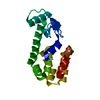
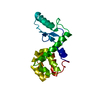
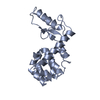
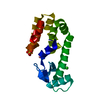



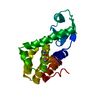

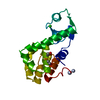

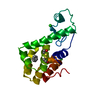
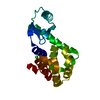

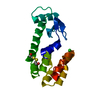

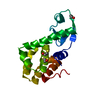


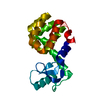
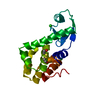
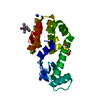
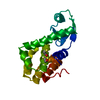
 PDBj
PDBj